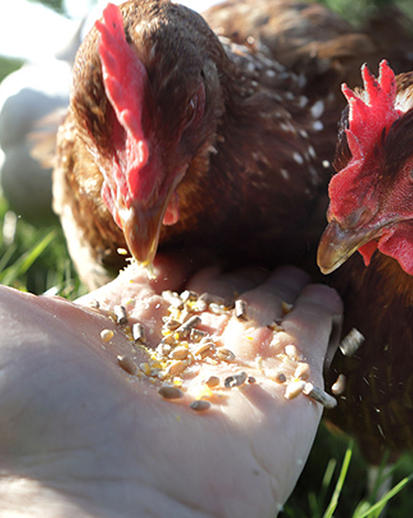Scope 3 GHG emissions
Our scope 3 emissions
Our absolute scope 3 GHG emissions amounted to 12 million tons1 CO2eq in 2020. Despite implemented reductions, total emissions increased by 0.4 million tons compared to 2019 (11.6 million tons), with the largest increase from emissions from Purchased goods and services. This was mainly due to an increase in total purchasing volume and a shift in raw material mix toward more carbon-intense raw materials compared to 2019. The main scope 3 categories in the 2020 figures remain Purchased goods and services and End-of-life treatment of sold products. End-of-life emissions remained stable compared to 2019 due to a restated value for 2019 to correct for an error in units. Due to rounding, total 2019 scope 3 emissions remain at 11.6 million tons despite the restatement on End-of-life emissions.
Other scope 3 categories reported comparable figures in 2020 compared to 2019. The scope 3 categories Business travel and Employee commuting reported a reduction compared to 2019 due to reduced travel and increased working from home as a consequence of the COVID-19 pandemic.
Scope 3 GHG emissions1
in CO2eq, million tons
We have seen considerable development regarding the performance of our main scope-3-contributing suppliers. Our highest-contributing supplier has already shown a decrease in emissions as a consequence of reduction measures taken in past years which now have been included in this year’s reporting. Furthermore, they announced an investment to further reduce their emissions in 2021. The second largest contributing supplier re-assessed their emissions and identified strongly increased emissions. As a consequence, they have started an investment to reduce their emissions drastically in the coming years.
Science Based Targets
In March 2019, our new Science Based Target was approved, including an intensity reduction target of 28% per unit of product produced in 2030 versus the base year of 2016 for scope 3 emissions. This year will be the first year reporting on the scope 3 intensity development.
The intensity development improved by 5% compared to the baseline in 2016. Baseline adjustments were made reflecting the new data insights and supplier-specific information.
Our emissions intensity deteriorated year-on-year. A change in product mix due to COVID-19 and the absolute emissions from raw materials was not offset by the improvements realized by our suppliers.
Engaging with our suppliers through our CO2REDUCE program
Our company-wide supplier engagement program CO2REDUCE continued at full force in 2020 and made good progress. We explored new means to support our supply base in emission reduction and improved our insights and data quality in the reported emissions.
The program continued using last year’s successfully developed roadmaps for our businesses, in which collaboration with key suppliers is fundamental. As a consequence, CO2REDUCE is well established in our businesses and we expanded the reach to more targeted suppliers that contribute the highest GHG emissions in our value chain.
Collaborating with our suppliers on scope 3 reductions
In our supplier engagement program, we apply a collaborative approach together with a given supplier whereby we aim to understand the supplier’s existing reduction ambitions and efforts, and develop a supplier action plan for reduction based on a common ‘reduction’ starting point. This typically involves the exchange of life cycle assessment data to establish the specific situation of a supplier. We have been successful in this approach, as multiple supplier action plans have been developed that have improved our insights in emissions while relationships with suppliers have been strengthened with a clear focus on next implementation steps for GHG reduction.
We greatly improved at tracking supplier developments and determining their realized reductions. This required an extension to the existing methodology and adjustment of the relevant IT systems. In the 2020 reported emissions, multiple supplier specific emissions were used in the calculations instead of using industry average figures.
An example is the halving of the carbon footprint of our polyamide Akulon® PA6 as a consequence of the committed reductions at our key supplier. To reflect this very promising development, this supplier specific reduction has been included in the CO2REDUCE reporting and will give a more realistic reflection of emissions development already in 2020 and years to come.
Sharing lessons learned on scope 3 emissions
To catalyze additional emission reductions through the use of renewable electricity in our supply base, we invited more than 40 participants from key suppliers to join a webinar on the transition from fossil-based to renewable electricity. We shared our lessons learned in this field and invited expert consultants to present the wider solution landscape and to accommodate an easy follow-up. The feedback of suppliers was overwhelmingly positive and the webinar series was nominated for the RE100 leadership awards for Best Green Catalyst.
The area of scope 3 emissions is a relatively new field that is in development and we regard it as our responsibility to actively support and share our experiences from the CO2REDUCE program in peer group platforms like Together for Sustainability. These platforms aim to define best practices on supplier engagement and scope 3 calculations within the industry. Our Supplier Engagement Rating on climate was given an A rating by CDP in 2020.
Finally, we also develop products for the circular and bio-based economy that contribute to further reducing our scope 3 emissions. See Stakeholder engagement and Resources & Circularity for additional information.
Avoided emissions, supporting our customers with their emissions targets
Our products can enable our customers to transition to a low-carbon economy through an inherently lower carbon footprint, or by helping our clients and end-users reduce their own emissions. The latter are referred to as ‘Avoided emissions’ — emissions-related environmental benefits that occur downstream in the use phase of our products. While avoided emissions do not count toward our own Science Based Targets or net-zero target, they result in reduced emissions for others in our value chain.
For example, animal farming accounts for 14.5% of all human-derived greenhouse gas (GHG) emissions. This contribution needs to be rapidly reduced to help limit the rise in global temperatures to 1.5°C. The farming industry is highly variable in its approach to transitioning to a low-carbon future so our Animal Nutrition & Health business provides innovative, customer tailored solutions to enable GHG reductions within animal production systems.
One of our solutions (approximately 1% of our poultry business) utilizes a combination of vitamins, enzymes, and eubiotics. This combination provides substantial greenhouse gas emission reductions in broiler production, where benefits related to animal health and digestion are realized. This performance improvement reduces the carbon footprint of produced poultry by more than 8% compared to non-use. In 2020, this enabled avoided GHG emissions of approximately 1,200 kt CO2eq.
Similarly, within pig production an example product combination (approximately 13% of our sales in this segment), leads to a reduction in emissions associated with animal feed production and animal waste when compared to non-use. The avoided emissions associated with this solution in 2020 were approximately 100 kt CO2eq.
Our feed additives are also used in dairy cattle feed, improving animal health and milk production efficiency. An example solution (representing less than 1% of dairy sales) reduces the carbon footprint of milk by 9%. This is associated with approximately 70 kt CO2eq of avoided emissions in this application.
1 All data presented in Planet are subject to the non-financial reporting policy.







